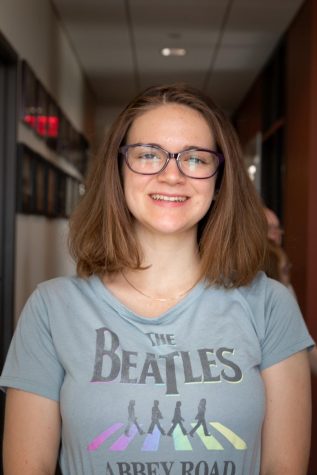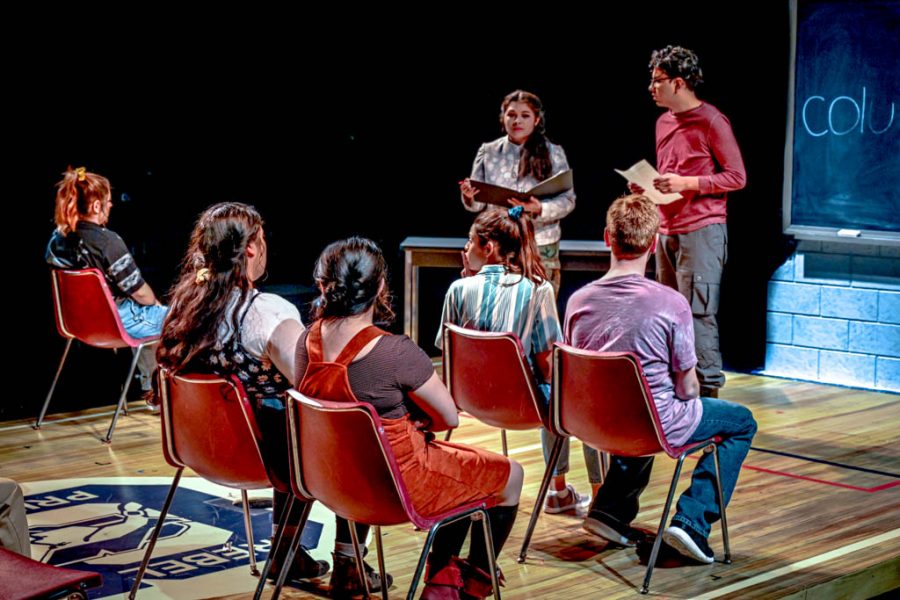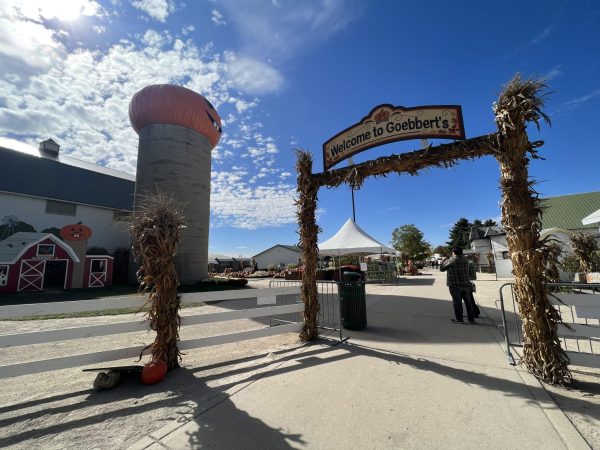A theater production with an ambitious goal
The United States Theater production of Columbinus is performed by the ECC Theater. The production runs Nov.7-17 in the Second Space Theater.
It is challenging work to be an artist as the criteria for judgment are subjective at best. It is also difficult to facilitate a discussion around an issue that has no easy or simple answer, but the “columbinus” cast and crew managed to do both.
Elgin Community College students performed “columbinus”, written by Stephn Karam and PJ Paparelli, this November in the SecondSpace Theater. The play “columbinus” follows the lives of Eric Harris and Dylan Klebold, the perpetrators of the Columbine High School mass shooting, on the days leading to and including the April 20, 1999 tragedy where 15 lives were lost. The writers gathered recorded dialogue, video and other evidence to create a thematic retelling of the events and characters such as, Eric and Dylan, based of the lives of the two boys.
All the actors embodied stereotypes of high schoolers for the first act. While not explicitly labeled, the stereotypes were redundant: the actor playing the character Perfect is wearing a bright yellow checker print blazer and matching pencil skirt with a headband holding back straightened shoulder-length hair. In an opening scene, individuals walk on stage in the spotlight, as others sit facing the audience comment on their perception of them. When AP walks down the center he adjusts his glasses before dramatically tripping while Rebel says, “Loser” and Jock says, “Smart”.
While this emphasis on ingrained stereotypes stifled character development, it served as an artistic device giving the setting a universal and relatable nature. The simplicity of the set matched the shallow archetypes.
A wooden stage made to resemble a high school gym floor sat at the center of fieldhouse-style seats for the audience. It was never difficult to hear what an actor was saying or view the entirety of the action. Shuffling of basic furniture would occur between scenes: a few plain tables and basic chairs made appearances serving as the pizza delivery counter, the dinner table and student desks. At the end of the stage was a blackboard that had the production title in chalk. The title was in all lowercase letters: an artistic choice expressed by the writers.
A projector on the wall above either side would display media periodically including a real transcript of a 9-1-1 dispatcher call with a Columbine teacher, a class photo on the Columbine High School class of 1999 and scene titles. Usage of such technology was engaging and humbling as it served as a reminder that the content was not purely fictional, but the scenes on stage had been a real situation.
A plethora of handheld props such as a camera, book, or basketball make appearances that aided the production although were sometimes too small to notice from a distance. An item that resembled a rock on a string when introduced was only identifiable a few scenes later when used by a student to time themselves on a practice standardized test.
While fake guns do make an appearance in the show they are present for one scene and are aimed at an individual only once. In lieu of a depiction of shooting at students and dramatized deaths, the two boys stand facing the blackboard and slap it to imply a shot fired as the students discuss from their point of view what was happening. These decisions seemed to have been done with an audience sensitive to violence in mind.
As Act I comes to a close and during Act II the characters although remaining nameless, sans Eric and Dylan, have their stories developed and depicted to be holistic and complex despite the originally predictable actions in the beginning.
The characters are shown with a personal struggle whether it be from an abusive relationship, poor mental health, controlling parents, relentless bullying, or academic pressure. As the various topics are touched upon in some way, a tribute is given to the lives of victims and what dynamic nature of a high school.
The two lead roles had many opportunities for a strong projection of emotion that were readily taken advantage of. Complementary characters, such as a teacher or parent, would engage Eric or Dylan and the sense of rage was shown obviously not just in their lines, but body language, tone of voice, and if that was not enough, the lighting would change. When Dylan angrily complains about the bureaucratic and impersonal nature of guidance counselors at the school the lights shift to a red hue.
One of the most emotional and best-done scenes of the production is a fight between Eric and Dylan in Act II. Eric is well portrayed as having a short temper and violent tendencies when he throws the first punch after being called a freak by Dylan. The physical fighting display was abstract, easy to understand, and fully engaged the audience.
Illustrating heavy topics on a community college stage brings unique challenges including working with busy students, limited resources and recognizing sensitivities in the audience may have to mental health and safety issues. While the acting was well done, poor lighting, exaggerated costumes and small prop choices distracted from the full potential the production had to captivate.
It is worth noting at this point that no one has been able to perfect stage performance (that I know of), and especially not one that transcends difficult societal issues into a digestible media of a two-hour play. I commend the effort of the students and the production team to chase such an ambitious goal.
Sue Klebold, mother of one of the perpetrators, expressed this sentiment at a Ted talk in 2016: “The tragic fact is that even the most vigilant and responsible of us may not be able to help [solve these problems], but for love’s sake, we must never stop trying to know the unknowable.”

This is my second year at ECC and I joined The Observer to meet new people and learn more about the school and community. In my free time I enjoy reading,...








